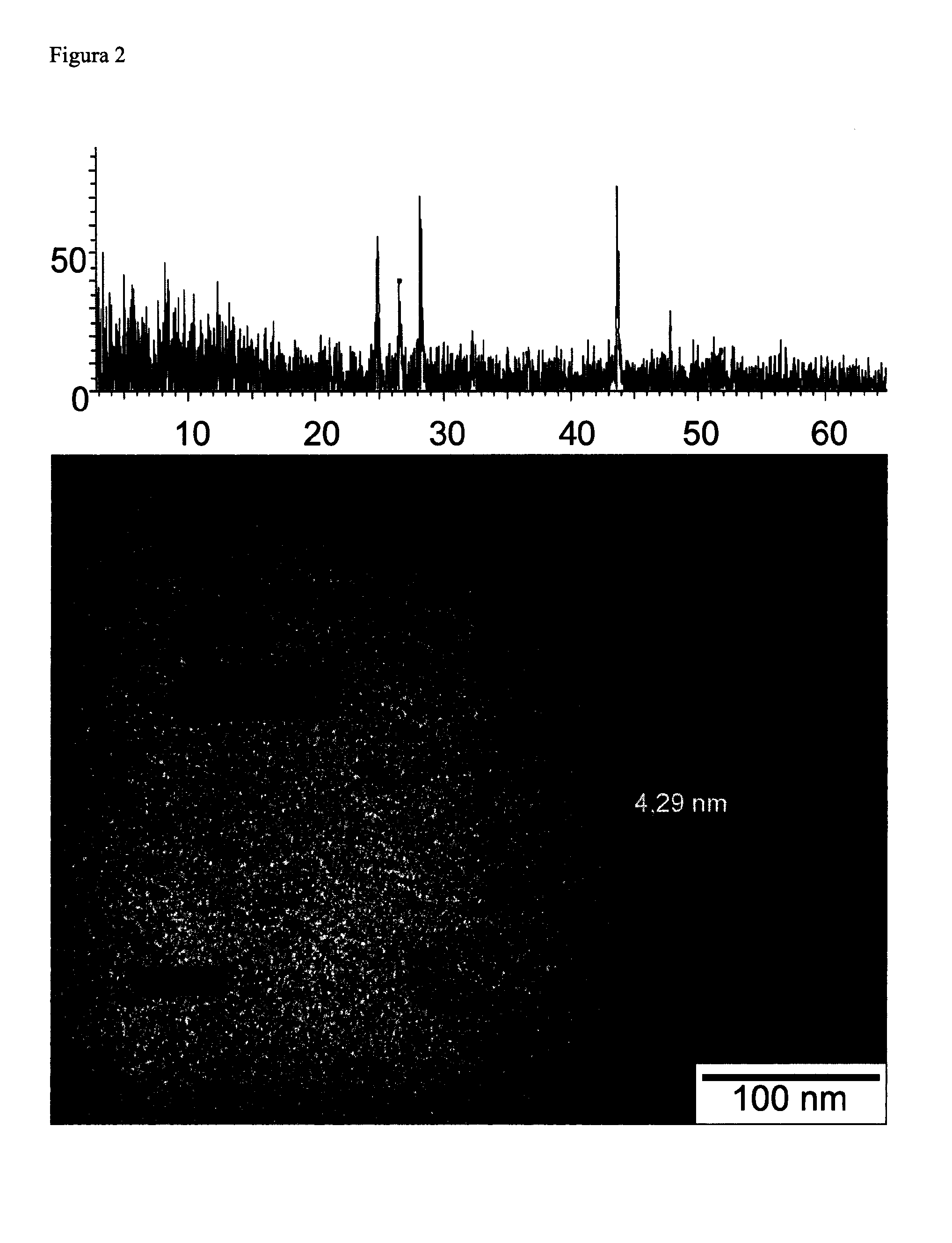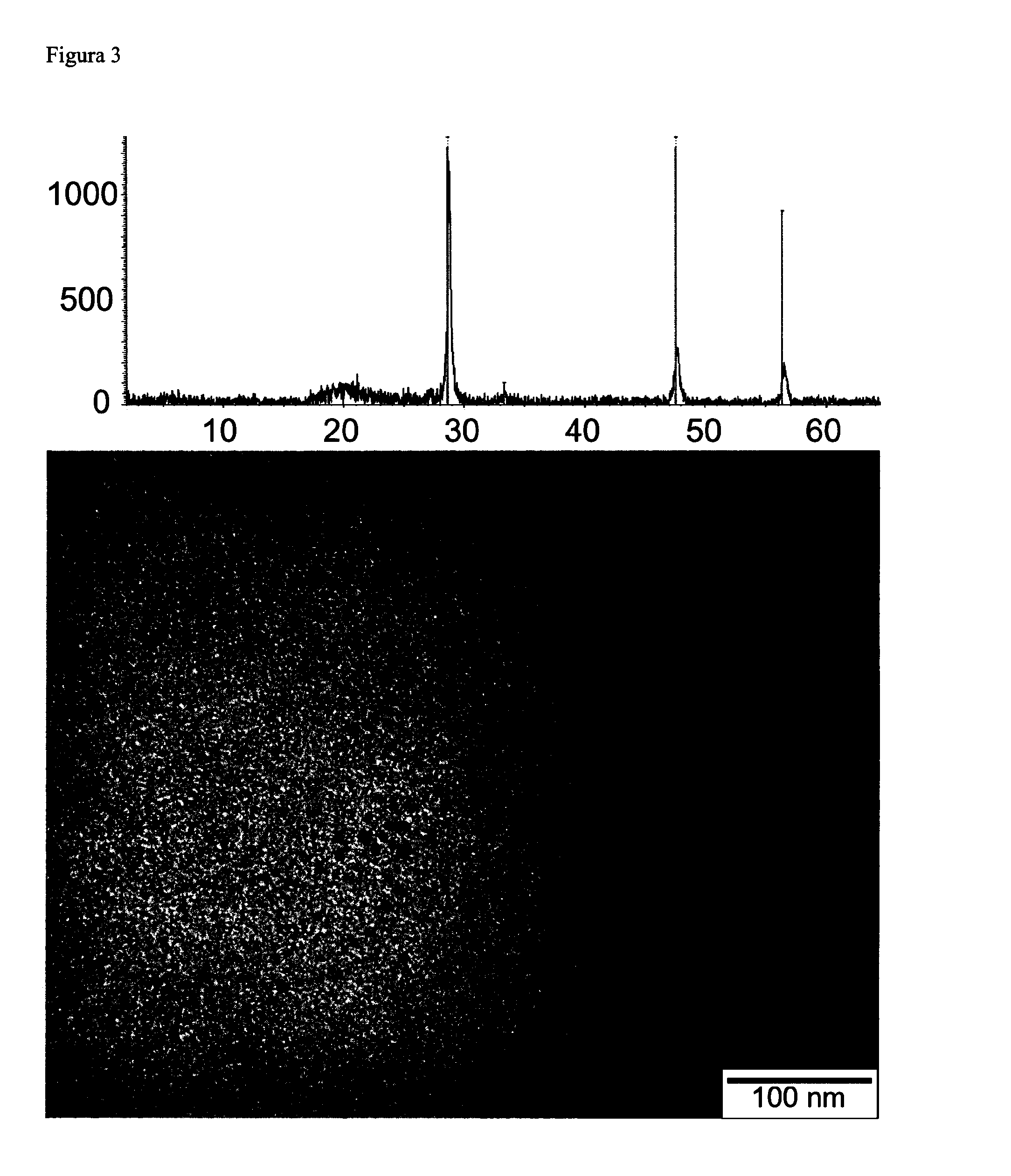Method for the preparation of nanoparticles in ionic liquids
a technology of ionic liquid and nanoparticles, applied in the field of nanotechnology, can solve the problems of not being able to prepare nanoparticles and also requiring organic solvents, and achieve the effect of simple, fast and effective methods
- Summary
- Abstract
- Description
- Claims
- Application Information
AI Technical Summary
Benefits of technology
Problems solved by technology
Method used
Image
Examples
example 1
Preparation of a Dispersion of Nanoparticles in an Ionic Liquid
[0081]General procedure. Approximately 0.05 g of the corresponding metal, metal oxide, metal halide, metal sulfide or metal selenide and about 5 g of ionic liquid are stirred between 700 and 1300 rpm at a temperature between 70 and 150° C. for approximately 2 to 6 hours. The mixture is cooled to 25° C., centrifuged at 3500 rpm from 10 to 20 minutes and decanted. The nanoparticles dispersed within the ionic liquid (FIG. 1) are characterized by the above described methods.
example 1.1
[0082]According to the general procedure of Example 1a yellowish dispersion of nanoparticles of cadmium sulfide, natural color of the formed nanoparticles [P. J. G. Coutinho et al., Annals of the New York Academy of Sciences, 1130, 2008, 242-246], was prepared in trihexyl(tetradecyl)phosphonium chloride starting from 0.05 g of cadmium sulfide and 5 g of trihexyl(tetradecyl)phosphonium chloride by agitation (1200 rpm) at 120° C. for 4 hours. As shown in Table 1 the absorption peak of the diluted dispersion in toluene obtained by UV-visible absorption spectroscopy appears at a wavelength of 430 nm. Any peak at 515 nm, characteristic of cadmium sulfide-size [S. P. Nair et al., Journal of Materials Chemistry, 12, 2722-2725, 2003], was observed. Its fluorescence spectrum has a peak emission at 450 nm (Table 1), indicating the fluorescence of the nanoparticles. The value of zeta potential, which is presented in Table 1 and that was measured in the Zetasizer, was −33.7 mV, showing that the...
example 1.2
[0084]According to the general procedure of Example 1, a whitish-yellowish dispersion of nanoparticles of zinc sulfide (ZnS) in trihexyl(tetradecyl)phosphonium chloride, characteristic colour of the prepared nanoparticles [M. Dhanam et al. chalcogenide Letters, 6, 12, 2009, 713-722] was prepared starting from 0.05 g of zinc sulfide and 5 g trihexyl(tetradecyl)phosphonium chloride by agitating (1200 rpm) at 120° C. for 4 hours. A toluene dilution of the dispersion of ZnS nanoparticles prepared in ionic liquid was analyzed by UV-visible absorption spectroscopy, resulting in an absorption peak at 310 nm (Table 1), typical of its nanometric size [J. H. Yu et al., Journal of the American Chemical Society, 127, 5662-5670, 2005]. We confirmed the fluorescence of the nanoparticles by studying their fluorescence emission, showing the fluorescence spectrum a maximum emission peak at 450 nm, as shown in Table 1, where the value of zeta potential is also showed, −33, 5 mV, indicating that the d...
PUM
| Property | Measurement | Unit |
|---|---|---|
| Temperature | aaaaa | aaaaa |
| Temperature | aaaaa | aaaaa |
| Size | aaaaa | aaaaa |
Abstract
Description
Claims
Application Information
 Login to View More
Login to View More - R&D
- Intellectual Property
- Life Sciences
- Materials
- Tech Scout
- Unparalleled Data Quality
- Higher Quality Content
- 60% Fewer Hallucinations
Browse by: Latest US Patents, China's latest patents, Technical Efficacy Thesaurus, Application Domain, Technology Topic, Popular Technical Reports.
© 2025 PatSnap. All rights reserved.Legal|Privacy policy|Modern Slavery Act Transparency Statement|Sitemap|About US| Contact US: help@patsnap.com



